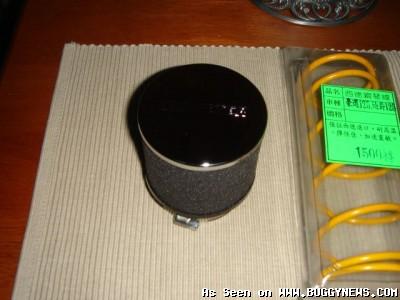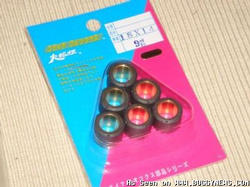THE TRANSMISSION
Working the Trans over!!
Once you get that motor up to snuff, you have to get the transmission/clutch/flywheel up to par!!
Inside the drive unit, or the Driver, there are small round weights. These weights slide in and out of the wheel, to engage the belt to the clutch. These are referred to as ROLLERS. How simple!!??!! Most factory rollers can be anywhere from 14 grams and up!!! That means, they are heavy, and at low RPMs, the clutch will be engaged. By altering the weight and going lighter, the engine will need to rev higher to engage the clutch. This will, in turn, bring your launches close to your powerband, and allow for faster launches, steeper hill climbs and so on. I chose on a basis of availability. Idealy, I would have liked to go with 10G rollers, however, they are currently out of stock. I chose to go a tiny bit lighter, rather than heavier, to better suite my needs. I chose the 9 gram rollers for now!!!
9 Gram Rollers:
Your CLUTCH or DRIVEN unit, on the other hand, is engaged by the belt. It grips the gear box though a shaft and planetary gear for your forward and reverse gears. The clutch drives teh shaft, which then rotates the chain that is attached to the solid rear axle. In order to get the most reaction and compression from the clutch, you can alter its internal compression by adding a stronger spring! The stock spring, i've been told, can be rated between 800 lbs to about 1000lbs. A very good modification when altering the clutch, aside from buying a different performance clutch, is the 1500lb spring!!! Again, my parts come from BLADE, www.bladeperformance.com!!!! The clutch spring is held inside the center of the clutch. To get to it, you need a table vice, and I used a carpenters sliding grip clamp to balance the clutch when puting it back together. CAREFULLY compress the clutch in the vice until it is snug, just below the center retaining nut. The nut is about 23-24 millimeters, however, it is difficult to get a wrench on it due to its thickness. I used a pipe or monkey wrench, but channel-locks would suffice. Unscrew the nut counter-clockwise, untill it is completely off the center shaft. Now, carefully hold the top of the clutch with your free hand, and SLOWLY loosen the table vice.try to balance the clutch as it upens up, so the spring does not shoot out and cause any harm!!!! once there is no more tension in the vice, simply take the clutch out in three pieces...front, spring, and rear sections...
Now comes the hard part...
Installing the heavy spring! You will put everything back into the vice, replacing the old spring with the new one, and making sure your bevel is lined up (flat spot on the shaft lines up with cluch cover flat spot) and you slowly compress the parts back togehter in the vice. I used the carpenters grip clamp at the same time on top, as the vice clamped the bottom of the clutch to keep everything even... Dont forget, you are compressing 1500 lbs of force, and this can be very dangerous!!! NEVER stand directly over the clutch, and be vigilent as you reassemble you parts to make sure all is aligned appropriately. As long as it is lined up, you can clamp it in all the way, and simply screw the nut back on tight! Now you have a higher spring rate, and a higher performance clutch!

